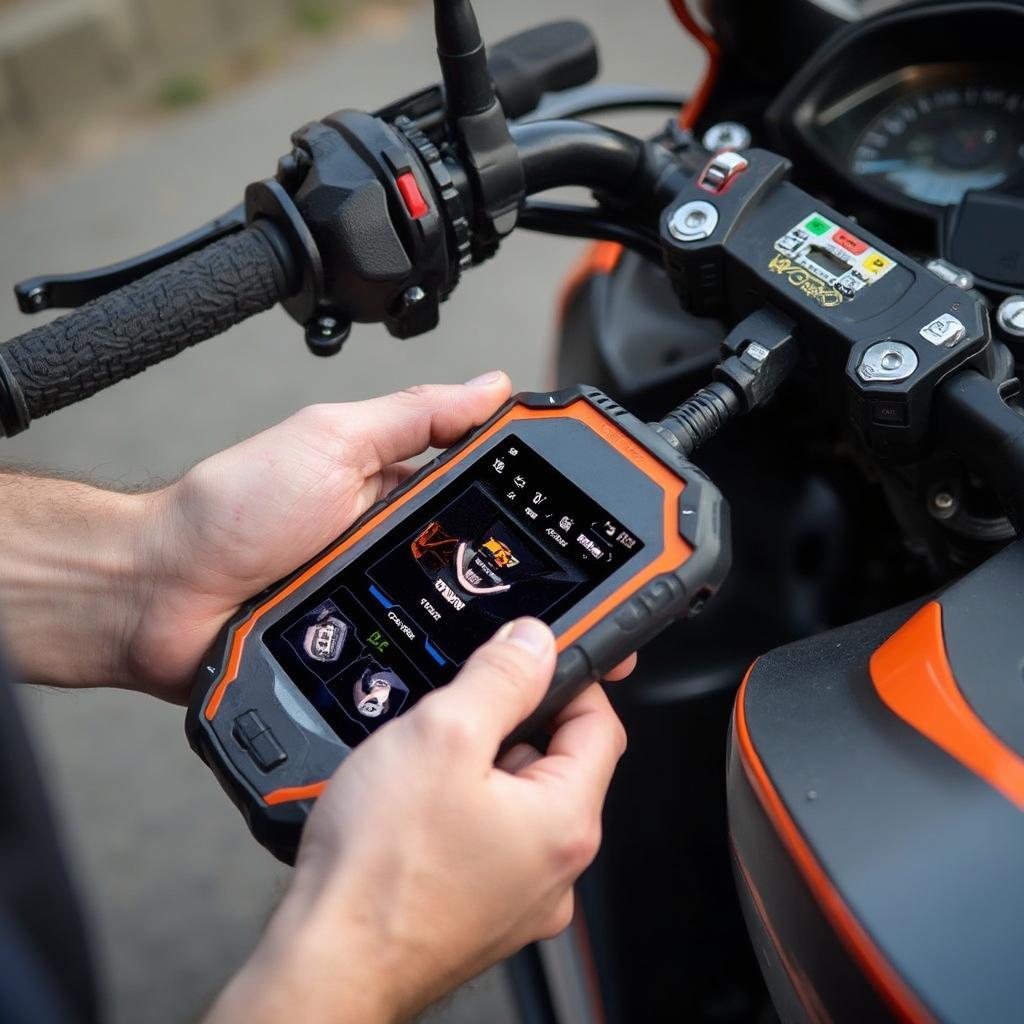Understanding the OBD2 sensor system on your Duke 690 is crucial for maintaining optimal performance and diagnosing potential issues. This guide provides a deep dive into the world of OBD2 sensors specifically for the KTM Duke 690, covering everything from basic functionality to advanced diagnostics.
Decoding the OBD2 Sensor on Your Duke 690
The OBD2 (On-Board Diagnostics II) system on your Duke 690 is a sophisticated network of sensors that constantly monitor various aspects of your motorcycle’s engine and emissions system. These sensors relay data to the ECU (Engine Control Unit), allowing it to adjust performance parameters and identify potential problems. Understanding how these sensors work can empower you to troubleshoot issues, enhance performance, and ensure your Duke 690 runs smoothly.
Why OBD2 Sensors Matter for Your Duke 690
OBD2 sensors play a critical role in maintaining the health and performance of your Duke 690. They provide real-time data on crucial engine parameters, allowing for precise fuel delivery, optimal ignition timing, and efficient emissions control. This translates to better fuel economy, improved performance, and reduced environmental impact. Moreover, a faulty OBD2 sensor can trigger the check engine light, providing an early warning of potential problems.
Early detection of issues through the OBD2 system can save you time and money on costly repairs down the road. By understanding the function of each sensor, you can pinpoint the source of a problem and take appropriate action. Whether you’re a seasoned mechanic or a DIY enthusiast, knowing how to interpret OBD2 data can empower you to maintain your Duke 690 in peak condition.
Common OBD2 Sensors on the Duke 690
Several key sensors contribute to the efficient operation of your Duke 690’s OBD2 system. These include:
- Oxygen Sensor (O2 Sensor): Measures the amount of oxygen in the exhaust gases, enabling the ECU to adjust the air-fuel mixture for optimal combustion.
- Manifold Absolute Pressure (MAP) Sensor: Measures the air pressure inside the intake manifold, providing crucial information for fuel injection and ignition timing.
- Engine Coolant Temperature (ECT) Sensor: Monitors the engine’s operating temperature, allowing the ECU to adjust fuel delivery and fan operation for optimal performance and efficiency.
- Throttle Position Sensor (TPS): Determines the position of the throttle valve, informing the ECU about the rider’s throttle input.
- Crank Position Sensor (CKP): Monitors the position and speed of the crankshaft, providing critical data for ignition timing and fuel injection.
Troubleshooting OBD2 Sensor Issues on Your Duke 690
When an OBD2 sensor malfunctions, it can trigger the check engine light and potentially affect your Duke 690’s performance. Using an OBD2 scanner can help you identify the specific sensor causing the issue.
Quote from Expert: “Regularly checking your Duke 690’s OBD2 system with a quality scanner can help prevent minor issues from escalating into major problems,” advises Michael Thompson, a certified motorcycle mechanic with over 20 years of experience.
Using an OBD2 Scanner with Your Duke 690
An OBD2 scanner is an essential tool for any Duke 690 owner. It allows you to read and interpret the data from the OBD2 sensors, providing valuable insights into your motorcycle’s performance and potential issues.
Choosing the Right OBD2 Scanner for Your Duke 690
With a plethora of OBD2 scanners available on the market, choosing the right one can be daunting. Consider factors such as compatibility, features, and budget.
Quote from Expert: “Investing in a high-quality OBD2 scanner that’s specifically compatible with motorcycles can significantly enhance your diagnostic capabilities,” says Sarah Miller, an automotive electronics specialist.
Conclusion: Mastering Your Duke 690’s OBD2 System
Understanding and utilizing the OBD2 sensor system on your Duke 690 is essential for ensuring optimal performance, diagnosing potential problems, and keeping your motorcycle in top condition. By using a quality OBD2 scanner and understanding the function of each sensor, you can empower yourself to maintain your Duke 690 effectively.
FAQ
- What is the OBD2 port on a Duke 690 used for?
- How can I find the OBD2 port on my Duke 690?
- What are the common symptoms of a faulty OBD2 sensor?
- Can I replace an OBD2 sensor myself?
- What type of OBD2 scanner is recommended for a Duke 690?
- How often should I check my Duke 690’s OBD2 system?
- Where can I find more information about Duke 690 maintenance and repair?
Need help with your car diagnostic tool? Contact us via WhatsApp: +1(641)206-8880, Email: [email protected] or visit our office at 789 Elm Street, San Francisco, CA 94102, USA. Our customer service team is available 24/7.

